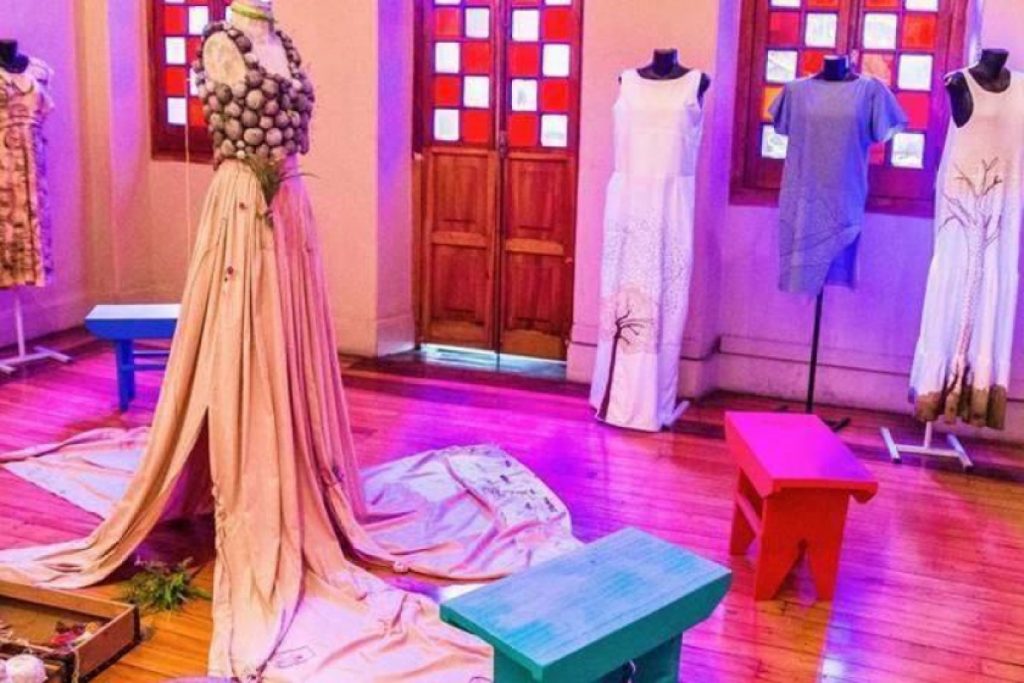A Line to Tell a Story
The Municipal Culture Foundation receives at the Museum of Fashion, until December 1st, the exhibition “A line to tell a story”, with the sustainable show developed by the stylist from Minas Gerais, Vanuza Bárbara. Composed of 33 looks and six bags, its theme is a character very present in the life of the miners: the train.
The exhibition’s plot evokes visitors to an inner journey with current questions and reflections on life.
Born in Ipatinga, visual artist Vanuza Bárbara has a timeless style and a form of production with a view to lower environmental impact and social inclusion of low-income women. Today his homeland has the second largest uniform production center in Brazil. And it was in these factories that the stylist saw potential for reuse for her productions.
A partnership that guarantees the capture of basic raw material for your work: the patchwork. The current concept, which goes against the grain of consumerism, caused the museum’s invitation to the artist to show up in the space.
The show occupies 150 m², with environments that tell stories and transport visitors on a train journey. One of the attractions is a tunnel, with dimensions of 8 meters long, 6 meters wide and 2.80 meters high. At the end, a mannequin with a skirt made of more than 11 meters of fabric is an invitation for visitors to let some of their history embroidered there.
Beside the mannequin, an infinity of threads of all colors, scissors and needles invite the public to participate in immersion in the world of fashion. In addition, the photos at the BH train station also adorn the gallery. The exhibition has resources from the Culture Incentive Law of the State of Minas Gerais and sponsorship from Provest Uniformes, Produtos Plinc and Fraldas Carinho.
Sustainability
In addition to being safer, rail transport has a low environmental impact when compared to road transport. This fact is important for the reflection of the artist, who has fashion conscious ahead of her fashion concept. In practice, it produces its pieces with a socio-environmental focus and reuses fabrics that the industries would use for garbage.
She also seeks in nature the extraction of pigments for the dyeing of fabrics, and obtains these colors from flowers, coffee, beans, leaves, spices, among other sources available in everyday life. All the pieces in the exhibition were made with fabrics from industrial waste, being produced with 100% reuse. Hundreds of pounds of scraps have been turned into unique pieces.
The production of the pieces of the show was made in partnership with seamstresses and local dressmakers, contributing to the financial independence of these women. Among the team members are the Embroiderers Group Making Art, with 30 skilled women who embroider each piece by hand, and a Venezuelan immigrant who came to Brazil with her family in search of better living conditions.
More than 100 people worked directly or indirectly for the exhibition, including stylist, cultural producer, art director, lighting, photographers, model, joiners, locksmith, dressmakers, modelers, embroiderers, painter, journalists and historians.
Concept
The stylist prepares a tour of the exhibition that is divided into 3 moments, making a parallel between life and the stages of a train trip. Firstly, “boarding” is presented as an environment of expectations and aesthetic appreciation of shapes and features. In this stage, the pieces have colder colors. Gray and jeans, with embroidery and paintings that refer to the architecture of railway stations, set the tone in the first part of the show.
In a second moment, “the tunnel”, marked by its absence of light, closes the perspective of what lies ahead representing the depressions caused by life’s difficulties. Doubts, pain, fear and insecurity are represented in clothes with shades of navy blue and asymmetrical cuts on the bars and sleeves. At this stage, the stylist seeks to reveal that it is often necessary to give up some habits, thoughts and behaviors to overcome these difficulties and find the famous tunnel light, which leads us to the direction we must follow.
The last moment that makes up the exhibition is “the arrival at the destination” representing that with strength and determination it is possible to overcome difficulties and achieve goals. The idea is translated into the softness and energy of colors, in fluid fabrics, and alludes to those who allow themselves the flexibility to go happier, with the ability to see life with.
Image courtesy of Museu de la Moda
